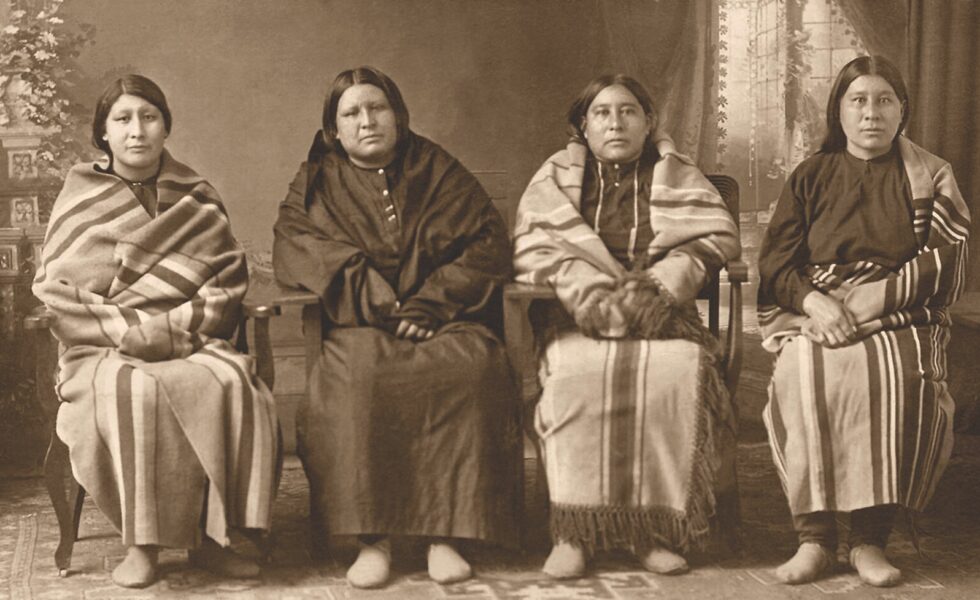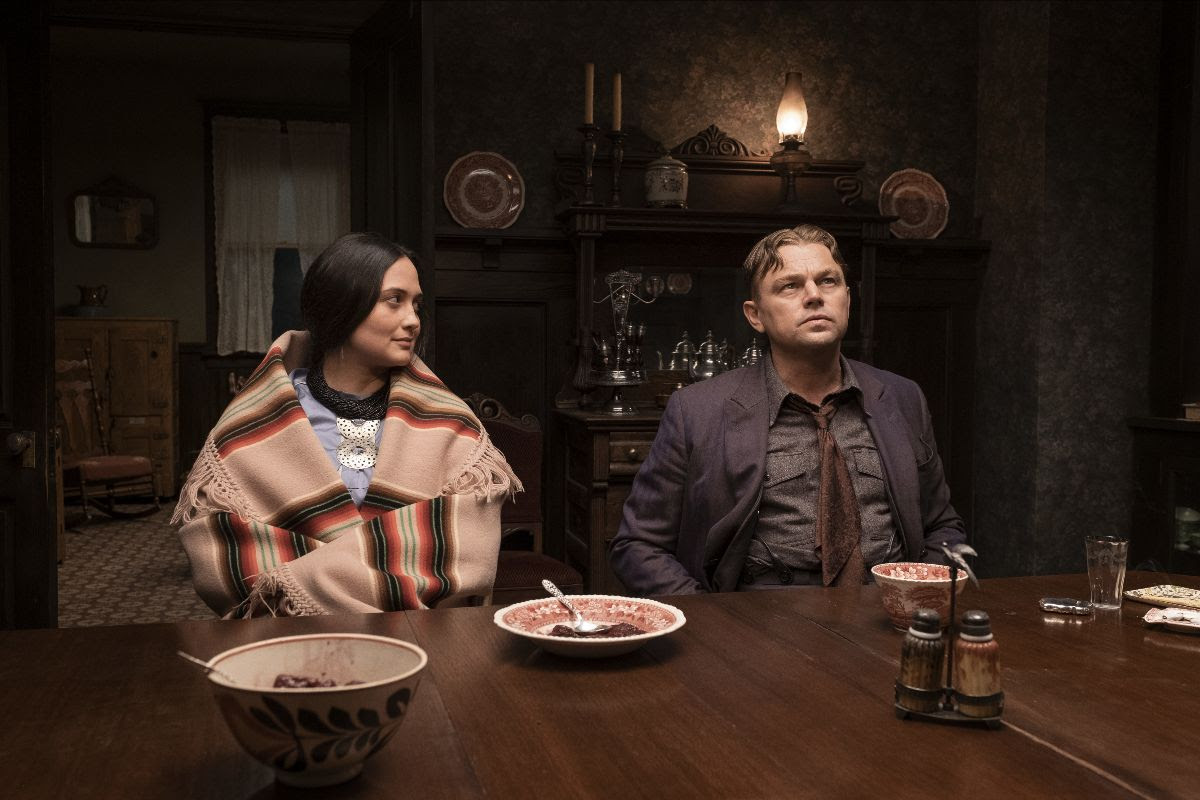Ernest Burkhart: You know, you got, you got nice color skin. What color would you say that is?
Mollie Burkhart: My color. ~from Killers of the Flower Moon (2023)
The latest Scorsese masterpiece is Killers of the Flower Moon. Well-acted, with magnificent scenery, filmed on location in Oklahoma, the beauty creates an unsettling contrast with the cold-blooded violence against innocent people. Molly Burkhart, played by Lily Gladstone, is particularly unforgettable, radiating wisdom and innocence even as she is overcome by unspeakable sorrow. I highly recommend reading the book by David Grann as well. I read the book before seeing the movie and it added to my appreciation of the depth of evil portrayed on the screen. Once again Native Americans are betrayed by Christian people who pledged to honor their commitments. In the case of the Osage in the film, most appear to be not only Christian but Catholic. The heroine Mollie Burkhart is a devout Catholic, shown in the film assisting at Mass and praying the rosary. She also prays outside in the Osage fashion; there is a lot of overlap between the rituals of the Church and the native rituals. The white people in whom they place their trust are for the most part Freemasons, who want the oil-rich property of the Osage at any price. They really think they have no obligation to honor their word to the Osage, making for a tragedy of unfathomable proportions. There are good white people who helped Molly and her family, such as the parish priest, Molly's housekeeper Vera (portrayed by my cousin Norma Jean), and the G-men sent from Washington to solve the serial killings, most of which are made to look like suicides. The majority of the murders are unsolved to this day.
From The Paris Review:
The larger setting is one of the most insidious criminal conspiracies in American history, a period known as the Osage Reign of Terror, wherein the white cattle rancher William King Hale colluded with associates, including Ernest, his nephew, to steal Osage oil fortunes. Sometimes this scheme involved white men marrying into Osage families and then sometimes murdering their new lovers. In the photograph, Mollie gazes over at Ernest, who’s looking up at the ceiling. In the frame, she is a Mona Lisa in semi-profile, a muse of multitudinous moods. What is that inscrutable expression on her face? Is she being coy? Flirtatious? Is that an inquisitive look? Or one of bemusement? Is she laughing at her beau, or at her predicament—the condition of falling in love with a racist doofus she knows is mainly interested in her money? (Oof.) (Read more.)
After many forced removals, the Osage acquired land in Oklahoma which turned out to be rich in oil. According to True West:
The Osage had a reputation for being fierce and powerful warriors. During the relocation of the Cherokee into Oklahoma in the early 1830s, they clashed with the Osage in a series of battles, forcing the U.S. to build Fort Gibson to protect the Cherokee. By this time, the Osage were hunting the Kiowa, who had just been expelled from the Black Hills by the Sioux. In 1883, the Osage slaughtered hundreds of Kiowa women and children at an unprotected village at Cutthroat Gap in the Wichita Mountains, leaving their cut-off heads in pots for the Kiowa warriors to find.
Treaties with the U.S. gradually forced the Osage onto a reservation in Kansas while they were employed as scouts for the U.S. Army against hostile plains tribes such as the Cheyenne. By the end of the Civil War, Kansas settlers wanted the lands of the Osage reservation. The Johnson administration placed pressure on the tribe to move to Indian Territory, modern-day Oklahoma, offering to buy their lands at 19 cents an acre. Tribal elders stalled until Ulysses S. Grant became president then sold their reservation lands to the new administration at $1.25 an acre.
With this money, the Osage managed to purchase from the Cherokee nearly 1.5 million acres, or most of the Osage Hills, with mineral rights and a greater degree of sovereignty than most tribes enjoyed. The tribe then auctioned off grazing leases for Kansas and Texan cattle ranchers, which made them one of the wealthiest tribes in the United States even before the Burbank Oil Field was discovered in 1897. The Osage demanded and received 10 percent of all revenues derived from oil found within the county, which was also their reservation. (Read more.)
The members of the tribe found themselves wealthy, but the wealth attracted a criminal element. From the Oklahoman:
Leading up to Oklahoma statehood, the U.S. Congress passed the 1906 Osage Allotment Act, legislating that property and mineral income be distributed equally among the more than 2,200 members of the tribe. One equal share became known as a headright — one right per head — and once a headright owner dies, it passes to the next legal heir, even if that heir wasn't Osage. Headrights allowed Osage to earn royalties on oil sales. Those looking for a share of those profits had to pay them for leases to explore and produce oil on their land, too. As demand grew and more and more oil was discovered, it generated millions of dollars for the Osage. In 1921, the federal government mandated that the Osage people were incapable of managing their own wealth and assigned court-appointed white guardians to them, many of whom often swindled them out of their fortunes. According to Grann, the Osage were considered the wealthiest people per capita in the world, earning $30 million in 1923, the equivalent of $400 million dollars today. (Read more.)
 | ||
| The real Mollie Burkhart, second from right, with her three sisters |
 |
| Mollie and her sisters in the film |
More on the casting, HERE.
My second cousin Norma Jean plays the part of Vera, the maid of the heroine Mollie. From WWNY:
Norma Jean got started in acting at the Watertown Little Theatre as a teen.“I remember the director telling me, ‘You don’t think you know what you’re doing, but you know what you’re doing,’” she said. “And I ran with that.” She eventually moved to California to pursue her dreams of acting, picking up roles in theater and film, eventually landing her in the right audition for “Killers of the Flower Moon.”
“Martin Scorsese is my favorite director of all time,” she said, “so I was elated and so nervous.” The movie is based on a true story from Oklahoma in the 1920s, when greedy white men started killing Native Americans from the Osage Nation for their oil rights. Vera is the housekeeper to the main characters, played by Leonardo DiCaprio and Lily Gladstone.
“They bring me to set the first day and I knew I was going to be meeting Leo and Lily and Mr. Scorsese,” she said. “Of course, it’s intimidating at first, but each one of us has the same Screen Actors Guild card in our packet — we’re all actors.” The movie has been a long time in the making. Norma Jean spent five months filming in Oklahoma in 2021.
“It really helped the character development as well because we were all immersed in that land where it all really happened and immersed in the people and that’s what pulled at my heartstrings,” she said. She says growing up in the north country was just the beginning of this path, which has aligned her with some of the greatest movie stars of our time.
“I’m 56 now, I was 54 when I got the role,” she said. “I never gave up and I was never willing to give up. You’ve got to have that tenacity in everything you do and that’s the message, kids.” (Read more.)
 |
| Norma Jean as Vera |
Share


















No comments:
Post a Comment